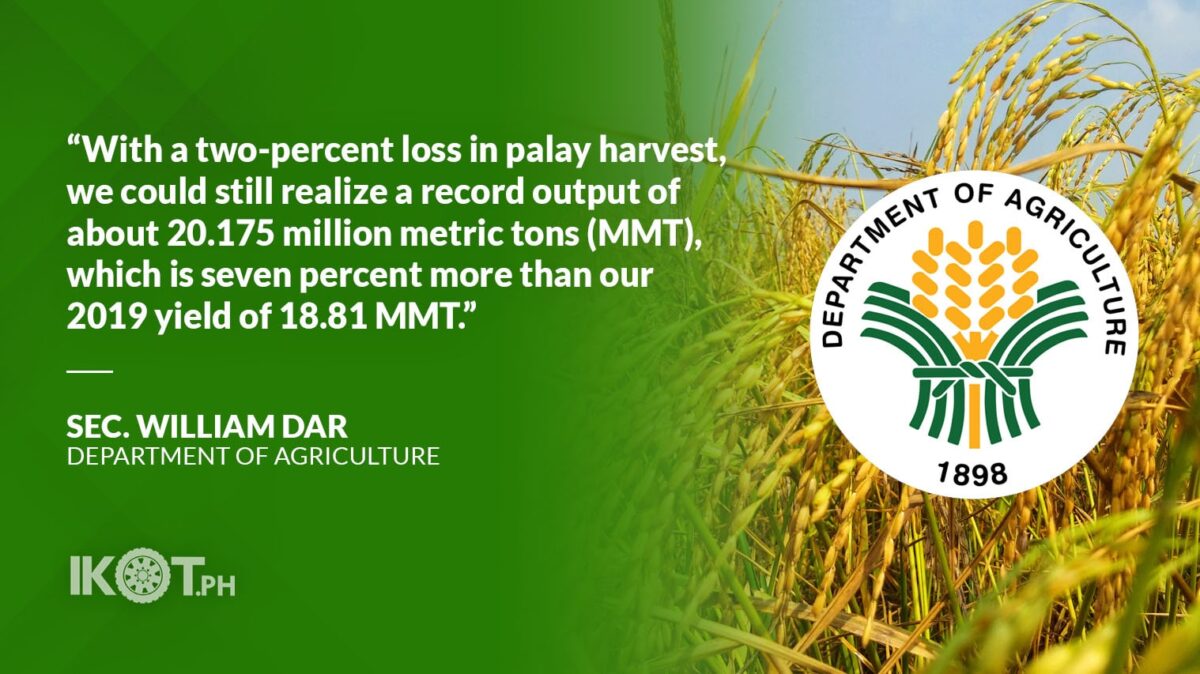With timely weather advisories, farmers were able to harvest early and thus “saved” their crops several days before typhoons Quinta and Rolly wrought damage to major rice-producing provinces in Luzon.
As a result, combined palay production loss amounted to roughly 165,000 metric tons (MT), representing two percent of the projected fourth-quarter harvest of 8.4 million MT.
“We hope and pray that in the remaining eight weeks of the year, we will be spared from strong typhoons, and thus our full-year production estimate would be realized,” said Agriculture Secretary William Dar.
The timely weather advisories have enabled farmers to save P7.66-billion worth of palay and P1.31-billion worth of corn from Typhoon Quinta; and P16.99-billion worth of palay and P579-million worth of corn from Typhoon Rolly.
Early this year, the Department of Agriculture (DA) has trained its sights on producing a total harvest 20.34 MMT of palay, banking on the combined results of the regular national rice program, rice competitiveness enhancement fund program, and rice resiliency project.
“With a two-percent loss in palay harvest, we could still realize a record output of about 20.175 million metric tons (MMT), which is seven percent more than our 2019 yield of 18.81 MMT,” Dar said.
“Our projected total 2020 palay harvest less losses due typhoons would be equivalent to 13.1 MMT of rice, or equivalent to 91.5% adequacy level based on per capita consumption of 118.6 kilogram,” explained DA Undersecretary for Policy and Planning Rodolfo Vicerra.
“Based on the trend over the past three quarters, we are confident that we will hit our palay production target this fourth quarter.”
“Based on the trend over the past three quarters, we are confident that we will hit our palay production target this fourth quarter, thus increasing our rice adequacy from last year’s 87%,” Vicerra added.
For the third quarter of 2020, palay production is expected to reach 3.542 MMT, which is 16% more than last year’s output for the same period, according to the Philippine Statistics Authority (PSA).
For his part, DA-Field Operations Service Director Roy Abaya said farmers in typhoon-affected areas were able to harvest their palay early, a week or two before typhoons “Quinta” and “Rolly” brought strong winds and intense rainfall.
Thus, they were able to save at least 1.6 MMT of palay or 7% of our total target volume of 20.34 MMT this year, due to early typhoon advisories, Abaya added.
By year-end, Vicerra said the country will have a comfortable level of rice inventory, good for 90 days.
Meanwhile, he debunked unfounded claims of farmers’ groups blaming the rice tariffication law for “weakening” the country’s ability to produce rice. They cited the PSA’s report on food availability and sufficiency from 2017 to 2019, when rice imports increased from 6.6% to 20.2% due to rice trade deregulation.
“We are expected to hit a record-high production of 20.3 MMT of palay this year.”
“The news reports are misleading, considering that we are expected to hit a record-high production of 20.3 MMT of palay this year,” Vicerra added.
He said that the higher level of rice imports does not necessarily translate to increased consumption, noting that the spike in the volume of rice from abroad was a knee-jerk reaction to the opening of the domestic market to imports.
“However, we can see that the market has already corrected itself,” Vicerra concluded.

